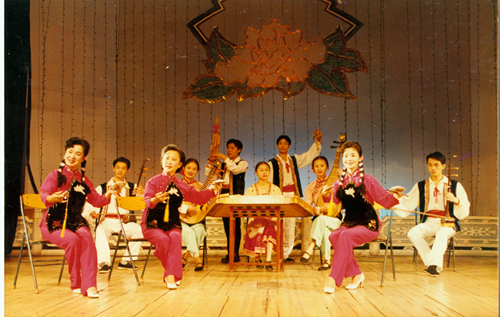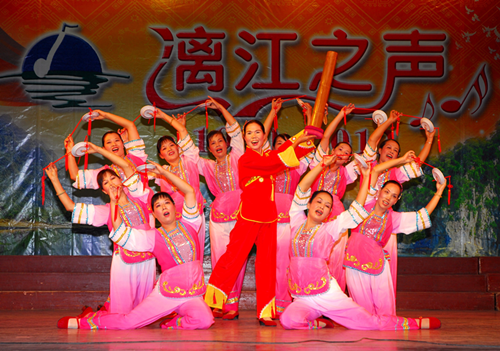National Culture Heritages in Guangxi (Chinese Quyi)
1. Guangxi Wenchang

Actors perform Guangxi Wenchang. [Photo/gxfybhw.cn]
Guangxi Wenchang, known as Wenjuzi and Xiaoqu, is a traditional singing art popular in northern Guangxi, especially in Guilin and Liuzhou. It is the most representative and influential traditional folk art form in Guangxi.
Centuries ago, songs from Jiangsu province and Zhejiang province were introduced to Guangxi and merged with the Guilin dialect. By the end of the Qing Dynasty (1644-1911), Guangxi Wenchang with Guilin dialect singing and local characteristics of northern Guizhou was formed. It is mainly singing, and sometimes speaking. The form is sitting and singing, with the number of singers determined according to the characters in the song book, with each person assuming a role. Each singer also plays an instrument, such as dulcimer, pipa, sanxian, erhu, and flute.
Guangxi Wenchang, with its traditional artistic charm, presents itself on the stage of literature and art with new content and new means of expression. On June 7, 2008, Guangxi Wenchang was listed in the second batch of the national intangible cultural heritage list with the approval of the State Council.
2. Guilin Fishing Drum

A Guilin Fishing Drum performance. [Photo/gxfybhw.cn]
Guilin Fishing Drum is a local traditional vocal performance art of Guilin, Guangxi Zhuang autonomous region. It was introduced into Guilin during the late Ming Dynasty (1368-1644) and the early Qing Dynasty (1644-1911) from Hunan province, formed in combination with the characteristics of the Guilin dialect.
Guilin Fishing Drum has a history of more than 300 years. It reflects the various life forms of ancient social life, which is of great significance for the study of the history of the way of life in Guangxi and the history of folk art in Guangxi. But it was also a gradual experience for fishing drums to really enter the lives of thousands of families in Guilin. The narrative, singing, and emotional performance form of Guilin Fishing Drum was deeply influenced by Hunan Fishing Drum.
In the 1930s, fishing drum artists could be seen beating fishing drums and singing in the busy places of Guilin markets and wharf. Guilin Fishing Drum is still welcomed by the local people in northern Guilin. Local people invite drum artists to give a fishing drums performance on occasions, such as the death of an elder to celebrate their lives or the marriage of young people.
In 2014, Guilin Fishing Drums were listed on the national intangible cultural heritage approved by the State Council.
